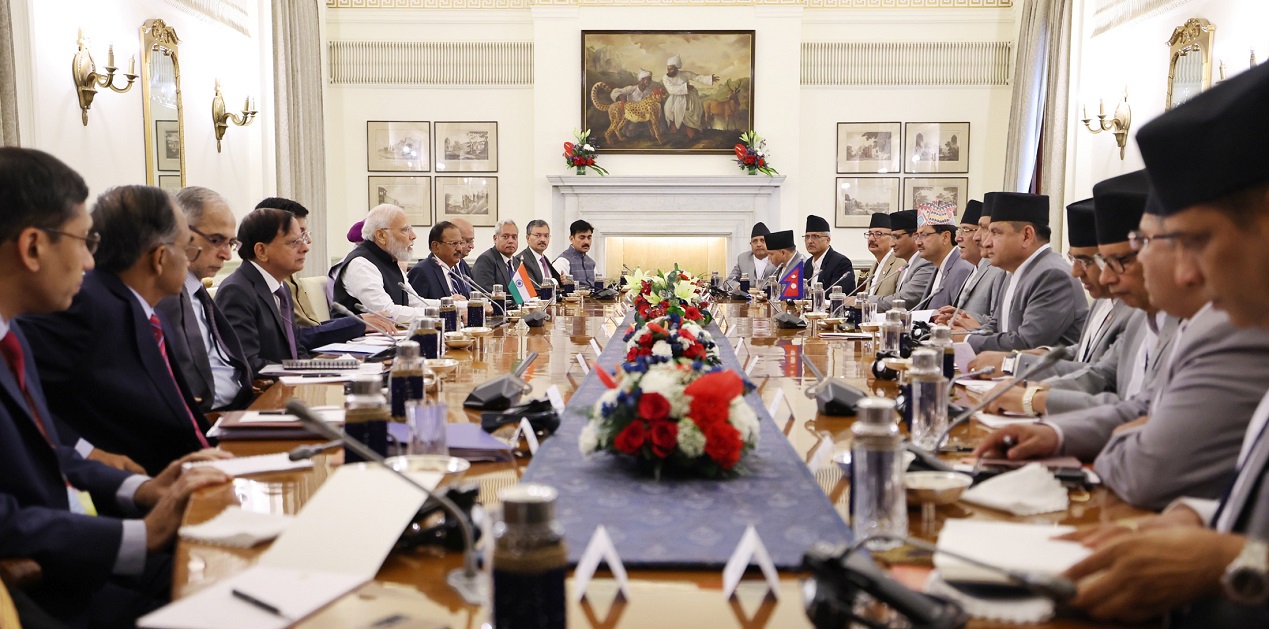Nepal’s Prime Minister, Pushpa Kamal Dahal’ Prachanda’, was on a four-day official visit to India from May 31 to June 3. It was his first bilateral visit abroad since he assumed office in December last year. It is his fourth visit to India in the capacity of the Nepal’s Prime Minister. Traditionally, Nepal PM’s first visit abroad has always been to India, even though PM Prachanda had preferred going to China in 2008 for his first bilateral trip as PM. PM Dahal’s first trip abroad after six months of assumption of the office is quite unusual for a Nepal Prime Minister. However, given the political circumstances, it was not a big shock. Even though the PM’s visit to India was initially scheduled for the month of March, the political storm that prevailed in Nepal made it impossible to visit at the time, shifting the dates constantly.
Political Turmoil in Nepal
In the general elections last year, former PM Sher Bahadur Deuba’s party, Nepali Congress, had won 89 seats, while K. P. Sharma Oli’s party; the Communist Party of Nepal (Unified Marxist–Leninist) had won 78 seats and PM Pushpa Kamal Dahal’s party, the Communist Party of Nepal (Maoist Centre), had won just 32 seats. Despite having a pre-election alliance with Nepali Congress, Prachanda outmanoeuvred Deuba at the last minute and formed the government with pro-China Oli in an unlikely friendship. In an attempt to sow the seeds of distrust between the coalition partners, Nepali Congress had extended its confidence to the Dahal-led government, resulting in a Parliament with no opposition. The coalition fell apart after differences over Prachanda’s support for Nepali Congress Presidential candidate Ram Chandra Poudel. It led to India-aligned Nepali Congress stepping in to form the government with PM Dahal.
Assessment of PM Dahal’s Visit
India and Nepal have exceptionally close relations. They share an open border that is characterised by not just education and job opportunities but a deep people-to-people connection and even kinship. The close economic, security and cultural linkages between the two countries have been a result of time-tested friendship, mutual respect and support. This unique relationship further received a new fillip with PM Dahal’s successful visit to India, which led to considerable discussions and engagement in the areas of energy, trade and connectivity, among others. The visit was a massive success as multiple MoUs and agreements were signed by PM Dhal and Indian PM Narendra Modi.
One of the defining areas of long-term and substantial partnerships between India and Nepal is the area of energy cooperation. Hydropower cooperation is arguably the most critical element of the economic partnership between the two countries. In a significant move, India agreed to allow Nepal to use the Indian transmission network to sell energy to Bangladesh as part of a sub-regional trilateral agreement. The first-ever trilateral power transaction will enable Nepal to export up to 40 MW using Indian grids. The move was largely symbolic as the energy export between the three countries is eventually expected to rise, and this was just to lay the groundwork.
Indian Prime Minister also announced the procurement of 10,000 MW of power from Nepal over the next ten years. The Nepalese counterpart initially pushed for a 25-year umbrella trade agreement on the energy cooperation deal with India. The ten-year energy cooperation is a substantial push for greater energy cooperation as at present India imports 452.6 MW of hydropower electricity from Nepal. Earlier, the approval for each project to export their power to India had to be renewed every year, creating uncertainty for Nepal. Thus, the announced ten years of power cooperation is a huge step in increased bonhomie between the two states.
One of the major agendas from the Nepalese side was establishing a deadline for completing the Detailed Project Report (DPR) of Pancheshwar Multipurpose Project (PMP). Both parties agreed to expedite the process, and a deadline of three months was set for finishing the DPR of the PMP. The PMP project has been stalled for 27 years since signing of the Mahakali treaty. The two parties also agreed to arrange the finances and conclude the modalities of implementation within the framework of a year, post the DPR approval.
Further, a MoU for the development of a 480MW Phukot Karnali Hydro Electric Project and the Project Development Agreement for the development of 669MW Lower Arun was signed, which will be jointly developed by the two countries. Both sides appreciated the progress in developing the 900 MW Arun-III hydroelectric project in Nepal. There was a groundbreaking of the 400kV Grakhpur-Butwal transmission line by the two leaders. A Line of Credit of around USD 679.8 million was also extended by the Government of India for the development of several transmission lines and their substations. The foundation stone was laid for the development of the petroleum pipeline, and MoUs for laying a new pipeline between Siliguri and Jhapa and the development of two greenfield terminals were also signed.
In the infrastructure area, the Tanakpur Link Canal construction was welcomed, and the technicalities were streamlined. Under the Indian grant, India agreed to build two bridges over the Mahakali River for better connectivity between the two countries. Further, India also committed to developing several Integrated Check Points (ICPs) to improve transportation and connectivity between the people.
Regarding connectivity, before reaching India, Nepal was also pushing for two-way traffic on the L626 and B345 air routes that would have shortened the travel time to the two new China-built international airports in Pokhara and Bhairahawa. Owing to India’s border security concerns near the air force base in Gorakhpur, India could only allow air traffic below 15,000ft over the L626 route. Regarding connectivity, the two countries signed the revised Treaty of Transit in a ‘once in a generation’ pact. In this treaty, Nepal will get access to India’s inland waterways.
Further, a MoU was signed to facilitate cross-border digital payments to enhance digital connectivity. Additionally, in the space sector, to allow Nepal access to the South Asia Satellite to allow more efficient digital governance, India, under grant assistance, offered to develop a ground station and supply 300 user terminals. The two governments also signed off on the cross-border freight rail operations on a rail link constructed with the help of Indian grant assistance. India also handed over the Kurtha-Bijalpura rail section and the location survey report for the Raxaul-Kathmandu rail link to Nepal while also promising the training and capacity building of the Nepalese rail officials.
The Balancing Act
Despite the long-standing friendship, Indo-Nepal relationship has often seen many ups and downs. The close proximity and an open border bring with it its own complications. Additionally, Nepal acting as a buffer state between India and China, and China’s attempts at interference in the functioning of the Nepalese state and politics has time and again put a certain amount of strain on the Indo-Nepal relationship. Balancing the two giants can be increasingly challenging for a relatively smaller Himalayan state like Nepal. Given the election results, the process of government formation and, subsequently, the foreign policy alignment of the new government had everyone on edge. However, PM Dahal’s visit makes it clear that India and Nepal continue to share the same vision as neighbours. The deep engagement, the development projects, and the MoUs signed depict a picture of mutual trust and respect. Such a vision of brotherhood showcased by the visit at once puts the questioning minds at rest about the position that the Dahal Government might adopt and, subsequently, India’s position on engagement with Nepal.
Nepal will inevitably continue to balance the influence cast by both China and India. For example, just before the visit to India, the President of Nepal, Ramchandra Poudel, endorsed the controversial bill to amend the Citizenship Act, which was strongly favoured by the Terai population. Since Nepal and India have a “Beti-Roti” (Nepalese men marrying Indian women) ties, many women could not become Nepalese citizens as they were subjected to the seven-year cooling off period after marriage to apply for Nepalese citizenship. The bill was previously stopped twice by former President Bidya Devi Bhandari in 2022 due to CPN (UML)’s reservations, despite the endorsement of both Houses of the Federal Parliament. The bill was passed right before PM Dahal’s visit to enhance trust and friendly neighbourhood relations.
However, at the same time, PM Dahal is playing his cards close to his chest. Right before he visited India on May 31, he was called on by a high-level Chinese official. According to sources, a delegation led by Wang Xiaohui, Secretary of the Sichuan Provincial Committee of the Chinese Communist Party, met with Prachanda and discussed matters of bilateral mutual interest. This 14-member Chinese delegation’s visit, which arrived a day before Prachanda visited India, received a lot of speculation. PM Dahal was also invited previously to the ‘Boao Forum for Asia’ by China from March 28 to March 31. However, PM Dahal cancelled the trip at the last minute after the new coalition of the Nepali Congress-Maoist Centre came up. It was also reported by Global Times, the media mouthpiece of China, that ‘to hedge the potential impact of Prachanda’s visit to India, it’s reported that Prachanda is likely to visit China next month or in early August.’
Overall, PM Dahal’s visit to India was a success that clearly reflected good neighbourly relations, long-term reliable partnerships and rising economic cooperation. Both parties had demands that needed to be addressed, and as a result of good faith, all parties reached a middle ground. Projects related to Ramayana Circuit were also promised to be expedited to enhance the cultural and religious roots. PM Dahal also offered his prayers at the Mahakaleshwar temple in Ujjain, Madhya Pradesh. Despite reservations about discussing the boundary issues by both sides, India and Nepal jointly resolved to come to a consensus on the border issue mutually. It showcases mutual trust and a promise of continued harmony and respect between India and Nepal.
(The paper is the author’s individual scholastic articulation. The author certifies that the article/paper is original in content, unpublished and it has not been submitted for publication/web upload elsewhere, and that the facts and figures quoted are duly referenced, as needed, and are believed to be correct). (The paper does not necessarily represent the organisational stance... More >>
Image Source: https://www.pmindia.gov.in/wp-content/uploads/2023/06/H20230601133008.jpg











Post new comment